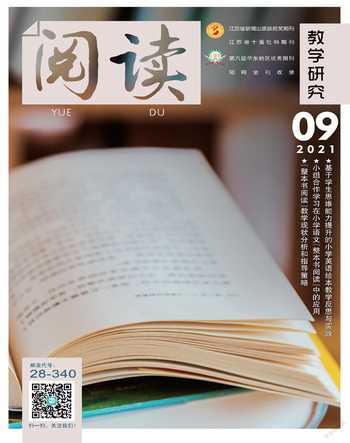创设语用情境,发展语言能力
2021-10-20姜琴琴
姜琴琴
【摘要】Checkout Time版块不仅承载着对单元知识的系统梳理、复习巩固和检测反馈的作用,还承载着提升学生语言运用能力的功能。在教授单元复习课时,应着眼复习内容,明确单元主题,设置整体情境。在整体情境的背景下,应厘清思路,确定一脉相承的情境串联主线,阶梯式设计学生的多种活动任务。
【关键词】整体情境 明确主题 阶梯式任务
译林版小学《英语》每个单元都包含了Checkout Time版块,这一版块通过不同的语言实践活动,旨在对各单元重点词句进行总结与检测,如:Listen and choose/number, Draw/ Point/Make order and say, Look/Read/Think and write等。此版块不仅承载着对单元知识的系统梳理、复习巩固和检测反馈的作用,还承载着提升学生语言运用能力的功能。教师在教授本版块时,如果零散教学,则无法帮助学生形成系统的语言知识概念以及综合语用能力。因此,创设真实有效的整体语用情境,循序渐进地发展学生语言综合运用能力至关重要。笔者以4B Unit 5 Seasons的Checkout Time版块为例,融合单元内容,以复习主题为源头,探索单元复习课之情境教学。
4B Unit 5 Seasons以季节为主题,目标语言是一年四季的气候及相关活动。Checkout Time版块是要求学生按四季、气候、活动划分的三组图片进行匹配连线,并以功能句型“In ... Its ... I ...”作出语言输出,本版块内容是对本单元教学内容的集中提炼。因此,笔者在教学时,以上一课时中的卡通故事配音为跳板,牵引卡通人物Sam和妈妈坐飞机去北京,见到自己最喜欢的春天,从而制作时下流行的季节手账为整体复习情境,将Checkout Time版块分解为识图、分类、匹配等子环节层层递进,进而拓展四季更多的活动。在帮助Sam制作季节手账时,逐渐呈现思维导图,从温度、活动、食物、服装、风景等方面帮助学生建构支点,呈现Sam喜欢的手账,为学生之后的语言输出提供语言框架。在完整而细致地呈现Sam的季节手账后,又以Sam與南通的好友Bobby互传季节手账为过渡,让学生同桌合作完成Bobby的季节手账,从温度、活动、食物、服装、风景等方面帮助学生复习和秋天有关的内容;最后,自然而然过渡到学生先完成自己喜欢的季节的手账,再小组合作完成四季手账。由此,学生在帮助卡通人物完成季节手账的整体情境下,逐渐丰富自己的语言框架和支点,综合提升语用能力。笔者根据以上情境教学思路,将教学过程实施如下:
Step 1.Warming up.
1. Enjoy and answer.
T:Hello, children! Are you ready for class? Lets begin! First, lets enjoy a song A sunny day.
2. Review and dub.
T:Its a sunny day. We can also say“Its a fine day.”Look, its a fine day. Sam and his mother take a plane to Beijing. Do you remember what they say on the plane? Lets dub.
[设计意图]课堂热身环节,由学生熟悉的课本歌曲入手,既能渲染气氛,又能让学生驾驭歌曲,激发其学习兴趣,同时自然牵引问题:歌曲里的天气如何?由“Its a sunny day.”牵引卡通故事中的“Its a fine day.”,顺其自然引入给卡通人物配音,为本节课的整体情境进行铺设。
Step 2. Presentation.
1. Enjoy and read: Enjoy some pictures of Beijing
T: Sam and his mother take a plane to Beijing. On the plane, they find a book Beautiful Beijing. First, lets enjoy some pictures of Beijing on the book.
2. Look and classify.
T:Oh, so many beautiful pictures of Beijing. Can you help Sam classify these pictures in three groups?
3. Match and say.
T: We have different weather and do different things in different seasons. This time, can you help Sam match these pictures? Open your books at Page 37 and try to finish. Check with your partner and then try to answer like this: In spring, its warm, we fly kites.
4. Think and learn.
T: We can do many things in spring. For example, we can go boating. We can draw in the park. How about in other seasons? What can we do? Lets think it over.
[设计意图]以上步骤将Checkout Time設置在Sam和妈妈在飞机上欣赏书上的图文的总情境下,依次串联,由浅入深分解为三个步骤:识图、分类和匹配。在学生为卡通故事配音后,延续文本情境:Sam和妈妈在飞机上发现一本书:《美丽的北京》,其中有许多图片,设置游戏让学生快速认读,复习文本词汇;接着让学生帮助Sam将这些图片分类,帮助学生引入概念:seasons,weather,activities,进而完成匹配,并进行同桌互查展示。在这一环节中,由点及面,循序渐进地帮助学生巩固单元知识,初步建构有关四季的认知。单元复习课,不仅应帮助学生系统掌握单元知识,而且应丰富、拓展学生的原有认知,建构更丰富的语言框架。所以,在完成匹配后,笔者自然引入话题“What else can we do in every season?”,由此丰富学生的语言储备,为之后的语言输出提供资源,也调动起学生学习新知的能动性。
5. Look and guess.
T: We can do many interesting things in every season. So we like different seasons. Which season does Sam like? Enjoy these pictures and try to guess.
6. Read and choose.
T: Its spring in Beijing now. Sam takes a lot of photos and he also wants to make a journal. Lets see what aspects the journal is from?(A.weather B.scenery C.activities D.food E.clothes)
7. Listen and compare.
T:But Sams mother doesnt think its very good. Take your learning list. Lets listen and fill.
T:How does Sams mother help him?Add some adjectives. Do you know other adjectives? Heres a tip for you. Using adjectives can help our sentences a lot.
8. Think and summary.
⑴T: Can you help Sam write something about clothes? Look, I help him like this: I wear a purple jacket. So Sams journal also includes clothes. When we write from many aspects, our journals can be excellent.
⑵What do you think of Sams journal? Is it full? I help him modify: which one is better? Why? Because I add the beginning and the ending.
Dont forget the title: Beautiful spring. You can create other titles, such as Green spring/Nice spring.
[设计意图]以上环节为本节课的主题情境,即:与Sam一起完善他喜欢的春季的手账,其中设置多种实践活动,通过听、说、读、思考、总结等方式帮助学生深层建构自己的认知。首先,呈现Sam自己制作的手账,由学生通过阅读思考总结季节手账的初步框架:天气、风景、活动、食物;然后教师提出建议:增加框架——服装,整体呈现思维导图;接着由Sam的妈妈提供帮助,学生完成学习单并思考:妈妈如何帮助Sam?由此引入使用形容词让手账更漂亮;最后呈现具有完整语言框架的手账与Sam的手账进行对比,引发小组讨论,总结得出在制作手账时所要注意的点。
9. Make and show
⑴Heres the full journal. Sam sends his journal to his friend Bobby in Nantong. Bobby wants to send back. Can you help him?
⑵T:Now we know Sam likes spring. Bobby likes autumn . Which season do you like? Can you make a journal about your favourite season? How to make a journal? Before class, you collect photos and pictures of your favourite season.In class, you learn how to write passages. What aspects can you talk? Heres a word bank for you. After class,you modify it and make it more beautiful. Now please try to make your journal.
[设计意图]在展示环节,笔者也分为两个层次进行:首先,呈现Bobby在南通喜欢的季节手账框架,包含相关图片和语言框架,学生依据图片和句型完成Bobby的手账。在此基础上,学生根据昨晚家庭作业收集的图片完成自己的季节手账,最后再与小组内同学合并为一本四季手账,并进行展示。在此展示环节,笔者依然遵循学生的自然发展规律,由浅入深,由点及面,从深度和广度挖掘学生的最大潜能。
Step 3. Summary
T:Sam likes travelling.He also likes taking photos. Lets enjoy some photos from Sam. In spring, we see flowers, happy animals. In summer, we go to the beach.We go swimming.We eat ice creams. In autumn, we get a lot of fruit. Its a harvest season. We can see nice apple trees. In winter, we make snowmen. We enjoy the white snow.
I think beauty is in every season. Get close to nature, you can find beauty everywhere.
[设计意图]在本节课大量的图片欣赏之后,笔者结合Sam在旅途中拍摄的图片进行解说,形成简短诗歌,让学生体会图片与语言的双重美感,从而激发学生对四季的热爱、对家乡南通的热爱、对祖国大好河山的热爱。
结合学生的课堂反馈,笔者认为,在教授单元复习课时,应着眼复习内容,明确单元主题,设置整体情境,此情境还应符合学生的日常认知,从而便于学生产生真实的体验感,确保语言交流的真实、有效。
(作者单位:江苏省南通市鹤涛小学)
